Our neurons use chemical energy to create a form of electricity.
Just like current electricity the impulses travel along nerves due to differences in charge!

We have to learn about two methods of transmission:
- Saltatory Impulse Transmission – Transmission along myelinated neurons.
- Synaptic Transmission – Transmission between neurons.
Saltatory Impulse Transmission
Due to ion movement that creates a small, temporary shift in the electrical nature of the fibre..
- Three types of ions are involved: Na+/ K+/ and negative ions.
- Note: We typically study motor neurons so we tend to discuss the transmission along axons. However the same process is found in all neurons
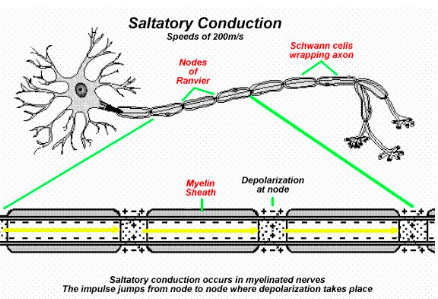
How it happens:
1. Resting state of a neuron:
- Outside neuron: Lots of Na+
- Inside neuron: Lots of K+ and negative ions.
- Axomembrane (membrane of axon) is lined with Na/K pumps that move Na+ out and K+ in (this takes energy)
- This uneven distribution creates a slightly negative (-65 mV) charge in the axoplasm.
- This is the resting potential!
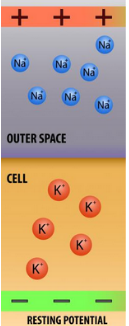
Depolarization (First half of “action potential”)
- A stimulus surpasses the threshold value (-55 mV)
- The axomembrane becomes permeable to Na+ (sodium channels open).
- Na+ floods into the axoplasm and reverses the electrical difference, creating a positive charge inside.
- Once the charge in the axoplasm reaches +40mV, the sodium channels close.When one section is depolarized, it triggers the next part to become depolarized.
- This creates a wave of depolarization along the axon.
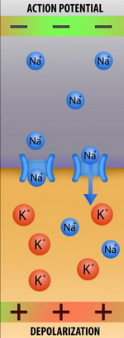
Repolarization (Second half of “action potential”)
- Sodium channels are closed
- Potassium (K+) channels open – K+ rushes out of the axoplasm (out of neuron).
- Na/K pumps return ions to their correct places (Na out/K in)
- Normal polarity is restored (-65 mV)
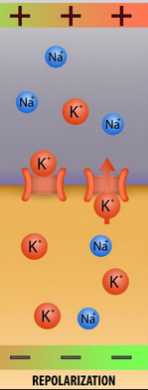
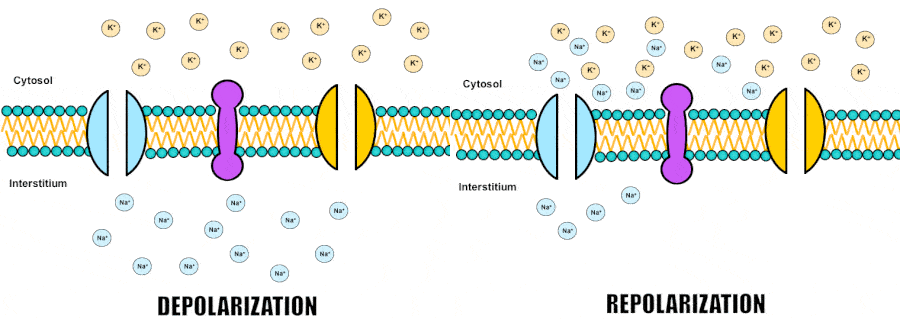
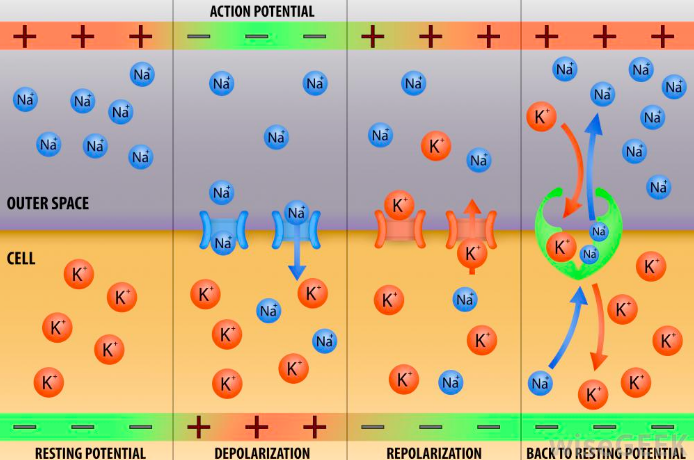
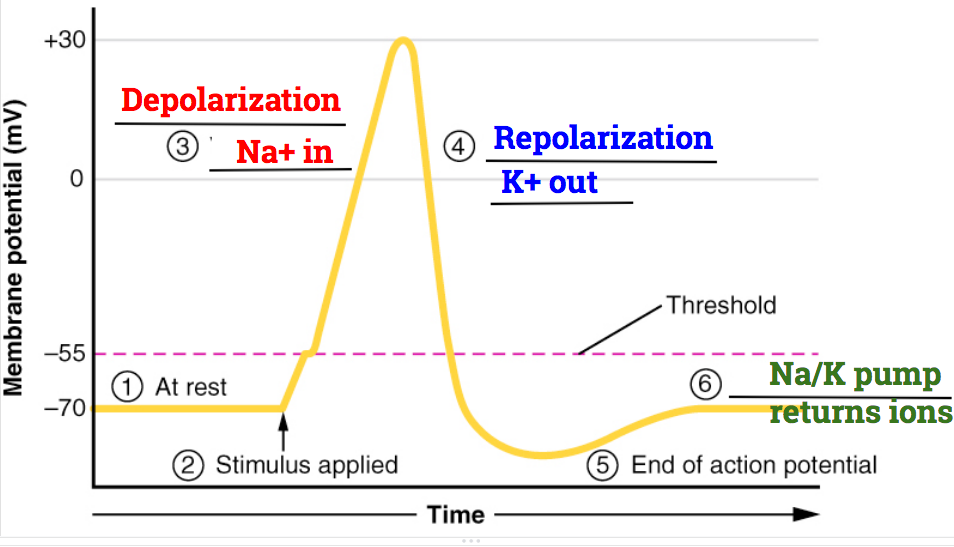
Remember: we see a wave of depolarization that carries the impulse.
- Myelinated axons speed up the signal because the myelin prevents ion movement.
- Thus, the wave actually jumps between the nodes of Ranvier, skipping a lot of the axon!
- Saltatory – from Latin “Saltore” to hop or leap.
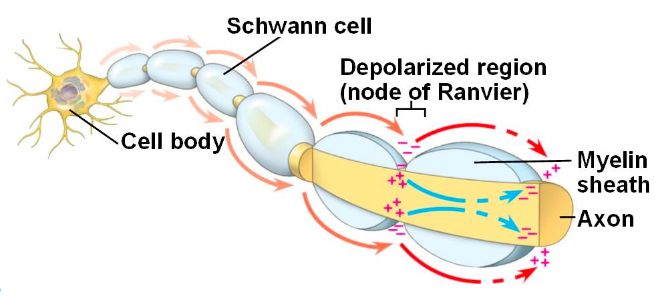
All or Nothing:
In class we will do an “All or Nothing” transmission analogy. Below is related to that activity:
This analogy is just like how an impulse is transmitted:
- There is either a significant stimulus to begin an action potential or there is not and nothing happens.
- The action potential does not change – it is always the same regardless of how “intense” a stimuli is.
- The intensity of an impulse is based on how many neurons get activated and how often.
Synaptic Transmission – Thursday, May 2nd
Since I am definitely not having fun watching “Shrek the Musical” in Victoria, Ms. Jeeva will be supporting you as you continue with these difficult notes (and Ann-Aleese will still have to complete this in Victoria). Normally when we do “Webquest” style notes I make the notes in question format. However, the feedback from students last time was that it was useful to search and apply the notes, but missing out on the regular note format was challenging for studying. Today, please follow the outline and make sure you are on task to complete the expectations – this can be a challenging section!
1. Watch the video below: “Crash Course: The Nervous System Part 3- Synapses!”
2. Fill out the remaining skeleton notes about Synaptic Transmission.
3. Answer the review questions about transmission on your skeleton notes and listed below.
4.Finish week 3/4 of the Takeaway Box assignment.
5. Create either: 1) A quizlet set of the key words listed below, or 2) Create physical flash cards of the key words below. (Or 3. Create something with the words below – draw a picture representation of each word!)
Next class:
- Quizlet Live – Transmission Key Words.
- Homeostatic regulation of the post-synaptic receptors: Focus on nicotine and opioids.
- Neurotransmission “relay” – the effect of different drugs.
- Peripheral Nervous System – Wrap up the unit!
Once an impulse reaches the end of an axon, it need to be passed to the next neuron, but between each neuron there is a small gap. This is called the synaptic gap or synapse.

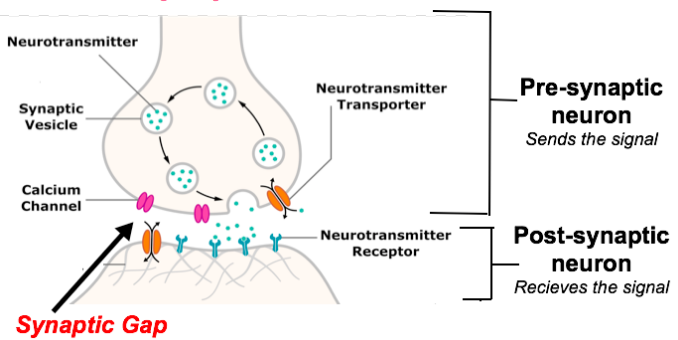
Synaptic Transmission – The process by which an impulse crosses the synaptic gap.
- The pre-synaptic membrane has Ca channels and many synaptic vesicles.
- Synaptic vesicles contain various neurotransmitters.
- The post-synaptic membrane has receptor sites that respond to a particular neurotransmitter.
- Each receptor can only bind a certain structure that lead to various biochemical pathways.
How it happens:
- Impulse arrives at the end of the axon. Arrival of the depolarization causes the Ca channels to open.
- Ca2+ enters the pre-synaptic axon from the synaptic gap.
- This causes the synaptic vesicles to fuse with the pre-synaptic membrane.
- Neurotransmitters move into the synaptic gap via exocytosis.
- Neurotransmitters diffuse across the synaptic gap and bind to the associated receptor on the post-synaptic neuron.
- When enough neurotransmitters have bound to receptors, sodium channels open in the post-synaptic neuron.
- This causes depolarization and the action potential to occur in the post-synaptic neuron!
Returning to normal:
- Each neurotransmitter has an associated enzyme that breaks down the neurotransmitters (so there is not a constant stimuli)
- Ca2+ ions are returned to the synaptic gap via active transport (takes energy).
Remember: Different sensory neurons receive different sensory information which can lead to different neurotransmitter release and acting on different parts of the CNS.
I.E. The difference between a motor response and a feeling of accomplishment is based on the sensory information, the neurotransmitter, and the biochemical pathway it activates.
Neurotransmitters:
Chemical messengers used to transmit messages between neurons
Can be:
Excitatory – Promotes depolarization and makes it easier for an action potential to occur.
Inhibitory – Makes it more difficult for depolarization to occur.
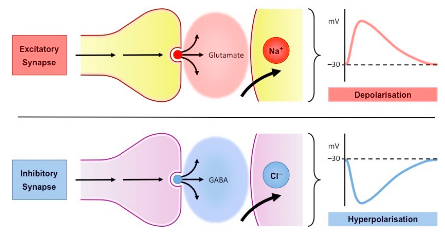
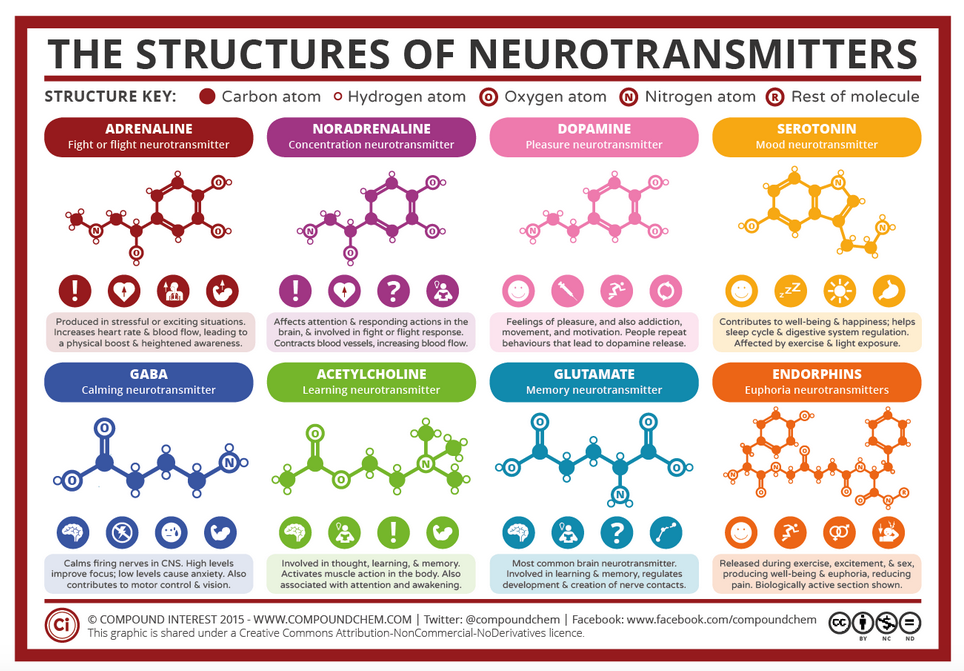
Think/Research: What are the effects of alcohol on synaptic transmission? What neurotransmitters are involved? Can you relate their function to the feelings/actions of someone being “drunk” (Obviously from movies you’ve seen or stories you have heard from people over the age of 19)?
I will ask about this Monday:)
Review Questions:
- Describe the electrical nature of resting potential.
- What is the role of the Na/K pump in an action potential?
- Are all impulses the same intensity/magnitude? Explain.
- Draw and annotate a diagram of the four stages of an action potential.
- How does a pre-synaptic membrane differ from a post-synapatic membrane?
- What would happen if dopamine was unable to be broken down by associated enzymes after release?
Words to know:
| Saltatory Transmission | Synaptic Transmission | Synapse | Neurotransmitter |
| Axoplasm | Axomembrane | Action Potential | Synaptic Vesicle |
| Depolarization | Repolarization | Resting Potential |
Unfortunately, we have to move fast this month. Be sure to review these challenging notes and come in from 8-9am or 3-4pm any day to get help or ask for additional practice!
Comments by shaun pletsch